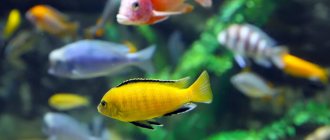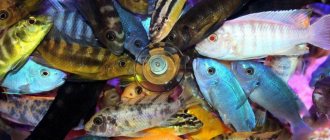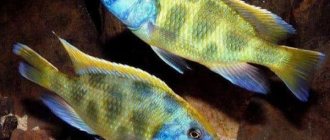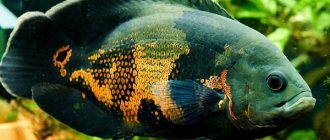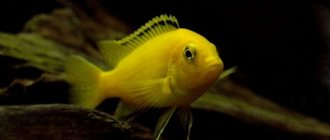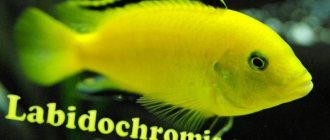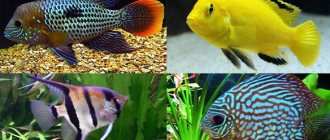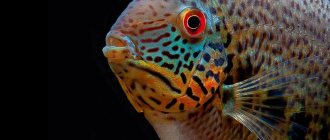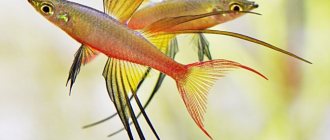Melanochromis johannii (lat. Melanochromis johannii, formerly Pseudotropheus johannii) is a popular cichlid of Lake Malawi, but it is also quite aggressive. The coloring of both males and females is very bright, but different from each other so much that it seems that they are two different species of fish. Males are dark blue, with lighter, intermittent horizontal stripes, while females are bright yellow. Both males and females are very attractive and active, making them very desirable in a cichlid aquarium. However, it is not so easy to keep with other fish, as they are aggressive and pugnacious.
Habitat in nature
Melanochromis Yohani was described in 1973. This is an endemic species of Lake Malawi in Africa, which lives at depths of about 5 meters, in places with a rocky or sandy bottom.
The fish are aggressive and territorial, protecting their shelters from their neighbors.
They feed on zooplankton, various benthos, insects, crustaceans, small fish and fry.
Belongs to a group of cichlids called mbuna. There are 13 species in it and they all differ in activity and aggressiveness. The word mbuna is from the Tongan language and means “fish living in rocks.” It perfectly describes the habits of the Yohani, who prefer rocky bottoms, unlike the other group (Utaka), who live in open areas with sandy bottoms.
Behavioral characteristics of the family Cichlidae
The behavior of these representatives of the underwater fauna is peculiar and attractive. Sociable and active by nature, cichlids are in constant motion, using the entire space of the aquarium.
Their activity increases in proportion to the increase in hunger. In pursuit of a portion of food, they organize real races and can instantly absorb everything that is offered to them, although such greed does not bring them any benefit.
Certain types of fish have highly developed hunting skills:
- nimbochromis, buried in the sand, pretend to be inanimate, thereby luring prey;
- Copadichromis, having a tube-shaped mouth, is able to easily suck in plankton like a vacuum pump.
The intelligence of cichlids is attractive to aquarists. They are able to recognize their owner and demonstrate unique social behavior.
Articles about cichlid fish on AquariumGuide.ru:
See the rules for caring for Managuan cichlasoma here.
With whom can you keep Cichlasama salvini fish?
Thus, almost all varieties of this family have developed parental care for their offspring. Cichlid aquarium fish carefully guard their clutches and care for the larvae and fry. Specifically, the Malawian species of fish hatch eggs in their mouths, and the hatched fry find refuge in the throat sac of their parents in a moment of danger. Therefore, with a relatively small number of eggs in these fish, their survival rate is quite high.
Feeding
Omnivores, in nature they feed on various benthos: insects, snails, small crustaceans, fry and algae.
In the aquarium they eat both live and frozen food: tubifex, bloodworms, brine shrimp. They can be fed artificial food for African cichlids, preferably with spirulina or other plant fiber.
Moreover, the high fiber content in the feed is very important, since in nature they eat mostly plant foods.
Since they are prone to gluttony, it is better to divide the food into two or three portions and give it throughout the day.
Breeding Melanochromis Auratus
Melanochromis auratus reproduces quite well in an aquarium. During the spawning period, the color of the male becomes much brighter and lighter. The female, ready for spawning, swims into his territory and lays about 40 eggs, after which she immediately takes them into her mouth. She then stimulates the male to fertilize. After the male releases the sperm, the female takes it in her mouth, resulting in fertilization of the eggs.
After three weeks, fully formed fry are born. Which can be immediately fed with Artemia nauplii or special dry food for fry. During the first days, the female protects her brood, allowing the fry to hide in her mouth in case of danger. It will be easier for the fry to survive until they grow up if you have a lot of hiding places in the aquarium in which you can hide from adult fish. Usually, three weeks after birth, auratus grow to a length of 2.5 centimeters.
Juvenile Melanochromis auratus
By choosing the right community of vegetarian fish in size, color and temperament, you can create a solid collection of Malawian cichlids in one large aquarium. Some aquarists advise adding small, nimble fish like rainbowfish to the auratus, which dissipate the aggression of the male.
Currently, as an endemic to Lake Malawi, Melanochromis auratus is in the Red List of the International Union for Conservation of Nature, under the status of LC (Least Concern), meaning that this species is not in danger of extinction.
Sources
- https://NashiRybki.ru/rybki/melanoxromis.html
- https://aquamir-za-steklom.ru/akvariumnye-rybki/melanokhromis-mayngano.html
- https://pets2.me/bok/1126-cihlida-melanohromis-mayngano-ryba-v-domashnem-akvariume.html
- https://aquarium-fish-home.ru/cixlidy/melanoxromis-majngano-afrikanskaya-cixlida-soderzhanie-foto/.html
- https://aquariumguide.ru/freshwater-aquarium/fish/melanoxromis-majngano.html
- https://www.aqvium.ru/ryby/tsikhlidy/melanohromis-chipoka
- https://kwitri.ru/vidy-akvariumnyx-ryb/melanoxromis-auratus-ili-zolotoj-popugaj/
- https://akvarium-online.ru/fresh-aquarium/presnovodnye-ryby/cichlidae/melanochromis-auratus-melanochromis-auratus.html
Keeping in an aquarium
For maintenance you need a spacious aquarium (from 100 liters), preferably long enough. In a larger aquarium, you can keep Melanochromis Yohani with other cichlids.
The decor and biotope are typical for the inhabitants of Malawi - sandy soil, stones, sandstone, driftwood and the absence of plants. Plants can only be planted with hard leaves, such as anubias, but it is advisable that they grow in pots or stones, since fish can dig them up.
It is important that the fish have plenty of hiding places, this will reduce pugnacity and conflicts in the aquarium.
The water in Lake Malawi contains a large amount of dissolved salts and is quite hard. The same parameters must be created in the aquarium.
This is a problem if your region is soft, and then you need to add coral chips to the soil or do something else to increase the hardness.
Parameters for maintenance: pH: 7.7-8.6, 6 - 10 dGH, temperature 23-28 ° C.
Reproduction and planting
Glossostigma elatinoides reproduces by shoots. The bush needs to be divided into small whorls of 2 leaves. They are then planted at a short distance in suitable soil. This operation must be performed carefully, since the stems of this flora are fragile. It's better to use tweezers.
If the conditions are suitable, then within a month the aquarium will acquire a beautiful green carpet. It is worth considering that whorls should not be planted next to glass. The distance should be at least 3 cm. Otherwise, the bush will begin to grow and begin to climb onto the walls.
The plant is planted in the foreground, and this is possible in several ways:
- Take a twig and sprinkle it with a small layer of soil;
- Plant the plant in bunches at a distance of 2 cm. This is the easiest and most proven way to get a thick carpet;
- This option is suitable for professionals. It consists of mixing flora. Glossa is planted together with the needle-shaped scutum or Eleocharis parvula. In this case, the glossostigma should fit into the “territory” of the second plant, due to which an interesting transition from one rug to another is achieved.
To make glossostigma look beautiful, you need to take into account several nuances. Firstly, the stems should not be allowed to tangle or overlap. Those stems that will be located under others will quickly die from lack of light. Therefore, the carpet must be trimmed in a timely manner so that its height is no more than 3 cm.
It is also worth making sure that:
- All stems were planted in the substrate;
- Those bunches that have not taken root should be removed;
- Accidentally pulled out sprouts should not be replanted;
- Regular pruning is necessary, otherwise the lower leaves will turn yellow and die;
- Stems affected by algae are discarded. In addition, it is necessary to adjust the daylight hours and the supply of parole with carbon dioxide.
Compatibility
It is a fairly aggressive fish and cannot be kept in a community aquarium. It is best kept in a species aquarium, in a group consisting of one male and several females.
Two males will only get along in a very spacious aquarium with plenty of hiding places. Although they are calmer than other melanochromis, they can still be aggressive towards fish of similar body shape or color. And, of course, to your own kind.
It is also better to avoid other melanochromis, as they can also interbreed with them.
Description
The genus Melanochromis belongs to the Mbuna group - “dweller of stones”. This definition is very arbitrary, but is found everywhere in the aquarium hobby. The fish are not large, but very active and aggressive. They live in harem-type flocks. The basis of the diet is algae growing on coastal rocks. The constitution of melanochromis has its own peculiarities: its body is elongated and narrow, almost round in cross section; the tail is small, the fins are narrow; The muzzle is wide, with a large mouth and eyes. Like many cichlids, melanochromis demonstrate characteristic spawning behavior, which consists in the fact that the male finds a convenient and cozy crevice in the rocks, where he lures, or rather drives, the female. At the same time, he jealously guards his nest from other males and other fish that can lay claim to it.
Breeding
When kept in an aquarium, melanochromis can attack the hands of the aquarist during aquarium care procedures, as well as tools. Females lay about 200 eggs at a time, which are immediately taken into the throat pouch. The male fertilizes the eggs, releasing milk at the moment when the female, mistaking the caviar spots on his anal fin for her eggs, begins to pull the rays of the fin. After this, the male soon loses interest in the female and the cave where she will now incubate the eggs. After 3-4 weeks, the fry emerge from the eggs and stay for some time near the mother, who, in case of danger, takes them back into the throat sac.
Having reached a length of 1 - 1.5 cm, the young begin an independent life. The basis of fish nutrition during this period is zooplankton. Already 10 days after the eggs hatch, the color of the fry begins to change, and before reaching sexual maturity it undergoes changes several times, until finally it is completely established. But even in the adult state, melanochromis are capable of changing color: if there are no males in the aquarium for a long time, the dominant female changes color to the color of the male, and vice versa: among bored males, some may turn into the colors of females. In the absence of females, males do not show as much territorial aggression, and therefore can be together. Sexual maturity occurs around one year. Spawning in pairs. Males remember their females.
Reproduction
Melanochromis chipoka reaches its sexual maturity at the age of 9-10 months.
Reproduction of these fish is not difficult in principle, but requires some care. Spawning takes place in an aquarium where fish live permanently. A sign that the female is ready to spawn is a small ovipositor that stands out on her body, in the area of the anus. Usually, no more than a day passes from the moment of its appearance until the moment of spawning.
During the spawning process, the female lays about 50-60 eggs, which she immediately collects in her mouth and thus incubates for about 20 days. The female should not be disturbed at this time, because during a fright, she can accidentally swallow her eggs, therefore, in order to preserve future fry, it is advisable to transplant the female immediately after spawning into a separate spawning tank with a volume of about 20 liters with a water temperature of 27-28 ° C. The spawning tank must be equipped with a water filter and an aerator. As a preventative measure, it is advisable to add methylene blue to the water of the spawning aquarium.
During the process of incubating the eggs in her mouth, the female becomes thin. She has a very prominent head, which seems overly large, which is caused by the increased size of the throat pouch.
